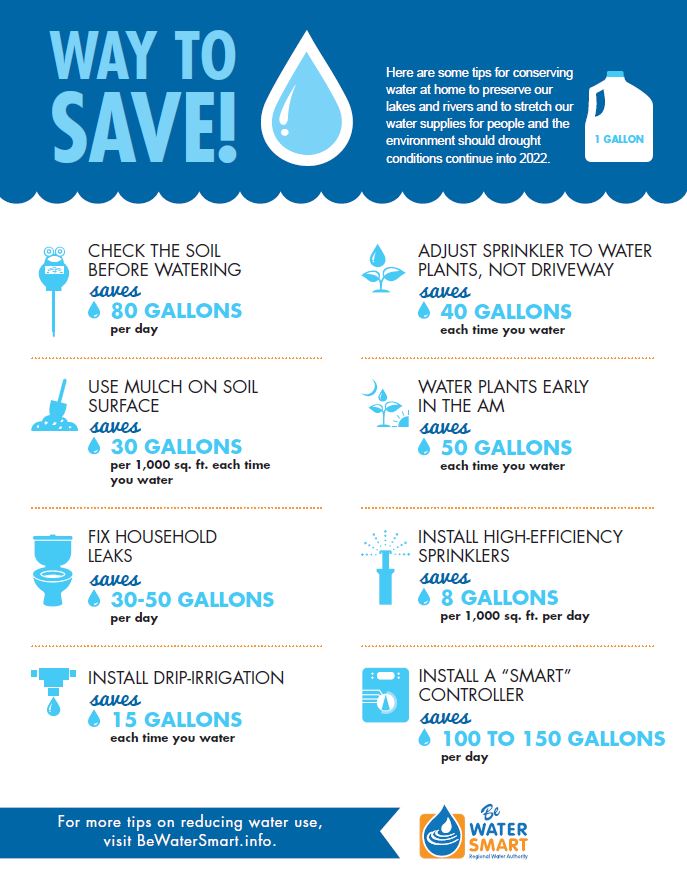“Summer Presents the Greatest Opportunity to Make a Difference”
SACRAMENTO—Sacramento-area leaders across the region’s major municipalities—including
the Cities of Sacramento, Roseville and Folsom and the County of Sacramento—are urging the public to increase their conservation efforts as severe drought conditions continue to unfold, impacting the environment of the Lower American River this summer and potentially next year’s water supplies.
The Sacramento region is experiencing the most severe drought of this century. What started as a near-normal snowpack, soaked into the soil or evaporated rather than flowing into lakes, reservoirs and rivers. By May, the snowpack was functionally gone, two months earlier than average, and Folsom Reservoir water levels were 68 feet lower than 2020.

“This drought is different. It has been swift and severe,” said Sacramento City Councilmember Jeff Harris. “Water supplies for people are expected to be OK this year, thanks to the region’s investments in and ability to shift to groundwater and share water among communities. However, it’s critical that we as a region look ahead to 2022 and prepare for continued dry conditions.”
Local water providers are using operational means to address current drought conditions by shifting to using more groundwater and sharing water around the region, options made possible in part by investments made following the last drought. In addition, RWA in May adopted a resolution calling for 10 percent voluntary conservation. Many local water providers have since initiated voluntary conservation measures and increased rebates as an incentive for customers to reduce their water use.
Increasing conservation this summer will help the environment of the Lower American River and decrease the potential for water shortages in 2022 if drought conditions persist.
“Summer presents the greatest opportunity to make a difference, so now is the time to act,” said City of Folsom Mayor Mike Kozlowski. Water use in the Sacramento region peaks in July and August, as residents increase landscape watering with the hot weather. “We are calling on everyone to do their part and conserve water, especially outdoors,” Kozlowski said. “We are confident our community will respond, just as they did during the last drought.”
The City of Sacramento has maintained a two-day-per-week watering guideline even beyond the drought, and other water providers have initiated new rebate programs. Overall water use in the Sacramento region is at least 10 percent lower than pre-drought levels.
“We are proud of the way local residents have continued to use less water since the last drought,” said Sacramento County Supervisor Patrick Kennedy. “Now, we are asking you to consider how to do more. We know our region will rise to this challenge.”
Several actions that can be taken immediately include:
- Stress Your Lawn and Save Your Trees. Try reducing lawn watering times by two minutes across the board, but remember to take steps to protect your trees. Lawn can handle less water and eventually recover while trees can be lost forever. You can find tips and videos for efficiently watering trees at BeWaterSmart.info/trees or sactree.com.
- Check soil moisture with a moisture meter before turning on sprinklers—saves 80 gallons of water per day.
- Water plants early in the morning to reduce evaporation—saves 50 gallons of water each time you water.
- Begin the transition to a beautiful low-water garden by removing half of your lawn this summer. You’ll be ready to add low-water native plants and drip irrigation this winter—saves 90 gallons of water per day per 1,000 square feet of lawn removed each time you water.
- Contact your water provider about rebates to replace older irrigation equipment, fixtures and appliances with high-efficiency models, including rebates on smart sprinkler timers, high-efficiency sprinklers, drip irrigation and more. Many have increased rebate amounts to help offset costs.
Information about how to implement these actions, additional water-saving tips and a map with watering guidelines for each agency are available at BeWaterSmart.info.
“In California, droughts are part of life and the next dry year is never far off,” said City of Roseville Mayor Krista Bernasconi. “While we are working to manage the severity of this year’s drought, long-term regional efforts build in a level of water resiliency that help minimize the impacts of future dry periods.”
The region’s water providers have developed a comprehensive water resilience portfolio called WaterFuture, which encompasses our entire “supershed” from the mountain tops of the American River watershed to the groundwater basin below the valley floor. You can learn more about this at rwah2o.org/WaterFuture.
The Sacramento Water Forum is a diverse group of business and agricultural leaders, citizen groups, environmentalists, water managers and local governments working together to balance two co-equal objectives: to provide a reliable and safe water supply for the Sacramento region’s long-term growth and economic health; and to preserve the fishery, wildlife, recreational, and aesthetic values of the lower American River. Learn more at waterforum.org.
The Regional Water Authority (RWA) is a joint powers authority representing 20 water providers serving 2 million people in the greater Sacramento region. Formed in 2001, its primary mission is to help its members protect and enhance the reliability, availability, affordability and quality of water resources. Learn more at rwah2o.org.

